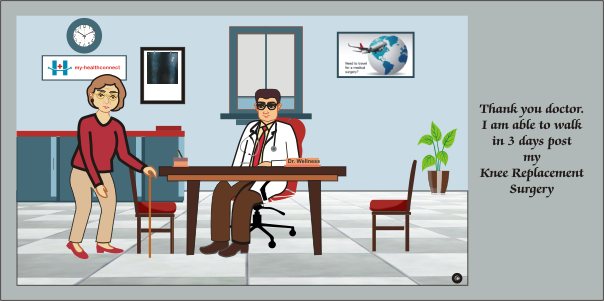“Will I really be able to walk in three days from surgery?”
“My neighbor’s surgery did not go well and now he is ridden to the bed. Will I meet the same fate?”
Knee Replacement surgery remains shrouded in a lot of myths, claims, and misconceptions. The one claim that is most enticing to a patient on the threshold of this surgery is that one can walk on the same day as the surgery or even within the first 8 hours! These are not entirely untrue but must be dealt with some caution. They may bet rue in the case of some but not applicable to every case.
Knee replacement or knee arthroplasty is a surgical procedure to reduce pain and improves the ability of patients with deformity or disability generally caused by injury or osteoarthritis.
How fast a patient is able to start getting on his feet varies from patient to patient. More than the age of the patient it depends on the condition of his muscles and his mobility prior to surgery.
Secondly, these days patients are made to walk on the same day as the surgery as it helps speed up their recovery and gives the knee a better range of motion. Range of motion at the time of hospital discharge is a very important factor. Patients need to have at least between 90 and 110 degrees range of motion to be considered for going home the next day. This can happen the sooner you begin walking.
The keys to great results after total knee replacement are pain management and control of swelling. Pain killers, therapists, exercises and walking aides together address both these problems. Exercises suggested by physiotherapists and occupational therapists are a must. All these are to ensure that they create a ‘better patient’ by having them be more functional and mobile at discharge. This includes being able to move in bed, get out of bed, and walk. If you have stairs in your home, it is important to be able to navigate those, and the therapist can help you master it. Initially one can take the support of walkers or crutches and later a walking stick or cane works fine until nothing is necessary. So from standing on your legs the day of the surgery to being able to walk free of support, pain and discomfort could take between 1 and 3 months.
Sub-vastus technique
‘Sub-vastus approach’ is a minimally invasive surgical technique. It is also called a ‘muscle sparing’ technique since the muscles are spared (not incised). It is commended for its ability to give earlier recovery due to less postoperative pain and early mobilization (due to rapid quadriceps recovery).
However, not everyone can leverage the complete benefits of sub-vastus technique. Good quadricep muscles (muscles around the knee joint) before surgery is a precondition. This is also reflected by gauging the range of movement. In fact, sometimes, surgeons may recommend physiotherapy prior to surgery to strengthen the knee muscles and only then make the patient undergo knee replacement surgery.
The case of Suguna, a 65-year-old lady from Kadapa, about 450 km to the south of Hyderabad. Suffering from pain in her knees due to long-standing arthritis, she wanted a way out. Surgery was playing on her minds for a long time now but wanted to ascertain some facts before proceeding.
She had heard of a friend’s aunt’s case gone awry. This aunt had to bear with excruciating pain for an exceptionally large duration, after which she was taken for surgery again. Some had said that the pain persisted even afterward. Some did not feel exactly normal after the surgery and the discomfort continued. Her need was to be independent, up and about and able. Else what could she do? All kinds of thoughts were racing through her head. She was confused.
Then, she heard of my-healthconnect and got in touch with them. This is a medical consulting portal that allows you to discuss your problem with experts in their fields. She was put under the able guidance of renowned Orthopaedic surgeon, Dr.Sudhir Reddy. After consultations with him and putting her every concern to rest, she went ahead. Much to her relief, she was able to walk well on the third day of her surgery.



